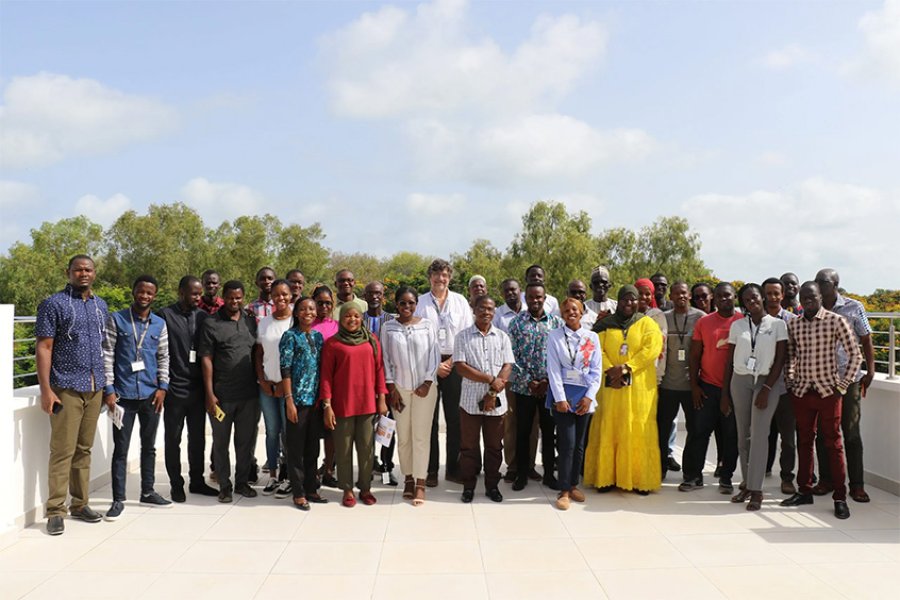
The training, held from 13th to 22nd July at the Unit’s campus in Fajara, involved fifteen (15) laboratory scientists from National Reference Laboratories in ECOWAS countries including Sierra Leone, Liberia, Mali, The Gambia, Guinea, and Guinea Bissau.
Funded by the West African Health Organization (WAHO), the training is part of efforts to develop capacity for laboratory staff to analyse viral genome sequences and interpret genomic data obtained by high-throughput sequencing.
The Unit’s genomics team trained the participants to sequence positive COVID-19 samples in real time using the ONT MinION platform. They were also trained to perform primary bioinformatics analysis of the sequencing data.
Dr Abdul Karim Sesay is the head of the Genomics Strategic Core Platform at the MRCG at LSHTM. He led the setup of the COVID-19 testing facilities as well as training of personnel locally. This increased capacity has translated into significant results, leading to The Gambia being ranked 6th in the world for the percentage of SARS-CoV-2 samples sequenced.
Highlighting the importance of next generation sequencing, Dr Sesay stated, “Prior to the COVID-19 pandemic, the importance of next generation sequencing (NGS) was to enable scientists to analyse the entire human genome in a single sequencing experiment, or sequence thousands to tens of thousands of genomes. NGS has been a fundamental tool used throughout the COVID-19 pandemic, helping scientists to study the SARS-CoV-2 viral genome and identify mutations. In the early days of the pandemic, one of the first steps was to characterize the virus and understand how quickly it was spreading. NGS was used to decode the first SARS-CoV-2 sequence very early in the initial outbreak, and this sequence was the springboard for many tools (including vaccines) developed to slow the pandemic.”
Expressing his appreciation on the recent advances in next-generation sequencing, Dr Sesay added, “NGS makes it possible to sequence large numbers of SARS-CoV-2-positive cases quickly and cost-effectively. Parallel advances in bioinformatics, computational biology, and molecular virology makes it possible to analyse the virus in context to assess risk in close to real-time.”
Jarra Manneh, the lead facilitator for the training, and a Higher Scientific Officer with the Genomics team said, “Generating sequencing data is no longer a big deal for the sub region since most countries can sequence their COVID-19 samples. What remains a bottleneck is how to make sense out of the huge amount of data generated. Therefore, training this group of people from different countries will help with reducing our inabilities to analyse sequenced data especially if these participants use what they have learnt and train others within their institutions.”
In 2019, the Unit’s genomics core facility became the first and only service provider for the Oxford Nanopore Technology (ONT), GridION platform in Africa after attaining the standard requirements by ONT. The Unit has established strong collaborative links with West African institutions in the field of genomics, enabling them to identify circulating SARS-CoV-2 variants.
Samuel Sorie is a Senior Medical Laboratory Scientific Officer at the Central Public Health Reference Laboratory at the Ministry of Health and Sanitation in Sierra Leone. He said, “This training is significant as it provides the knowledge and skills needed currently to respond to public health problems in the African region. Bioinformatics is a rare topic and is urgently needed, but the skillset is scarce in the African region. Hence, this training means so much to me and my country. I can now be able to analyse sequence data and provide the information needed for outbreak responses, research, and development of health policies.”
Sidonie Ablavi Kagnissode is a Pharmacist-Biologist at the BIOLIM laboratory of the Faculty of Health Sciences at the University of Lomé in Togo. She said, “The practical work went well. We became familiar with the basic commands of a terminal, as well as how to analyse and interpret the sequencing data. We formed groups and handled our own samples. The instructors let us handle our own samples, and they were very attentive and patient with us. We learned a lot.”
At the end of the 10-day bioinformatics training, participants were able to analyse viral genome sequences and interpret genomic data obtained by high-throughput sequencing. Participants were also able to use the command line to analyse viral next-generation sequencing (NGS) data, quality control of sequences, reference mapping and de novo assembly of viral genomes, pathogen identification from metagenomics data, and creating phylogenetic trees.
Our postgraduate taught courses provide health practitioners, clinicians, policy-makers, scientists and recent graduates with a world-class qualification in public and global health.
If you are coming to LSHTM to study a distance learning programme (PG Cert, PG Dip, MSc or individual modules) starting in 2024, you may be eligible for a 5% discount on your tuition fees.
These fee reduction schemes are available for a limited time only.
